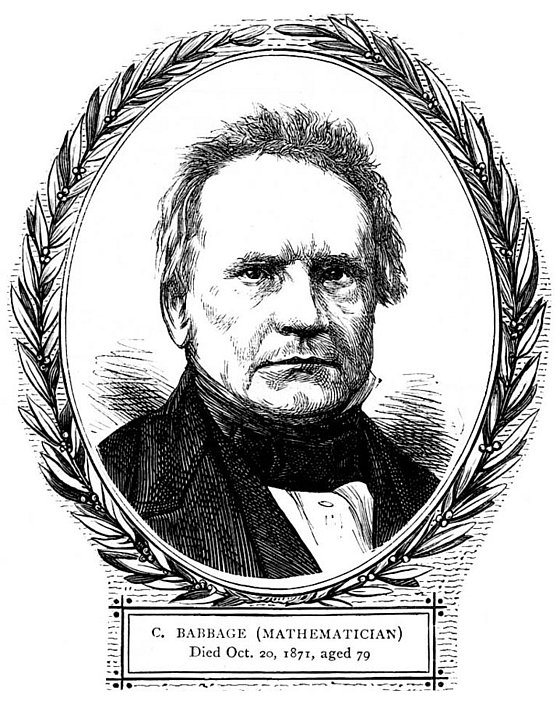
1824 - The foundation stone for computers is laid
Prof. Dr.-Ing. Dietmar Tutsch / Automation Technology / Computer Science
Photo: UniService Transfer
The foundations for the computer were laid 200 years ago
Electrical engineer Prof Dr-Ing. Dietmar Tutsch recalls Charles Babbage, whose pioneering idea of an analytical machine was forgotten.
Today, it is impossible to imagine society without computers. However, the groundwork for it actually began 200 years ago. Charles Babbage, mathematician, philosopher and inventor, created the first calculation concept for a computer in the early 1820s. Electrical engineer Dietmar Tutsch took a close look at Babbage and his life, whose ground-breaking invention was nevertheless forgotten.
"Charles Babbage was an English scientist and a multi-talent," says Tutsch. "He became known as a pioneer because he created the template for designing a computer." Although the machine was never realised, he was awarded the gold medal of the Royal Astronomical Society for this calculation concept exactly 200 years ago, in 1824.
Babbage developed the Difference Engine in 1822
As a precursor to the analytical engine, Babbage first developed the so-called Difference Engine in 1822. "This machine was used to analyse mathematical polynomial functions, i.e. more precisely, to calculate their function values. Polynomial functions are used for simplification purposes to approximate or replace more complex functions. These functions are then often presented as tables in mathematical reference works so that they can be read off directly," explains the expert. Babbage therefore built a machine that calculated precisely these tables and, of course, functioned purely mechanically at the time.
The concept of the analytical machine
In 1837, the Analytical Engine was finally designed. Tutsch explains: "In principle, the Analytical Engine was a further development of the Difference Engine into a mechanical calculating machine for more general calculations using algorithms. That was completely new! Until then, a step-by-step procedure had always been used, i.e. one calculation after the other, without any influence or decisions being made during the calculation." Tutsch knows that automatic loom control systems as those used in the textile industry in Wuppertal also functioned according to this principle. "A new feature were the leaps in the design. For example, depending on a previous result, calculations could be skipped, i.e. omitted, or you could jump back to a previous calculation point to perhaps do the same thing several times but with different numerical values. These jumps in various forms are the core of every computer programme today." As the machine was never built, he says, one can only speculate about its appearance, although one must assume that there are many precisely ground individual parts, such as gears and spindles.

Portrait of Ada Lovelace, public domain
Ada Lovelace - the world's first female programmer
Ada Lovelace, daughter of the romantic poet Lord Byron, was partly responsible for the later success of this calculation concept. Known today as the world's first female programmer, she contributed the precise functional description of the machine. "Ada Lovelace recognised the added value of this analytical machine, these algorithms, which made it possible to do much more than just calculations. She drafted a precise description of the analytical engine; including a programme algorithm for calculating Bernoulli numbers (Bernoulli numbers are among the most important constants in mathematics, editor's note)." Tutsch emphasises that the fact that she as a woman was able to make and realise this invention at that time is particularly noteworthy. The programming language Ada, which was used in real-time systems, i.e. computer systems in which temporal conditions had to be fulfilled, was named after her.
Doubts from scientific experts prevented funding
On the recommendation of the British Association for the Advancement of Science, the analytical machine was ultimately not built. As the machine would have consisted of many individually manufactured parts, experts doubted its accuracy at that time. "The lack of accuracy made it impossible to estimate the costs," says Tutsch, "so they advised against building it and did not provide any funding."
Babbage the inventor
You might think that Babbage would have retired in frustration, but this was not the case, as he had done crucial groundwork in various other areas. We now know that he was the first scientist to decipher the Vigenère cipher, an encryption method for text messages dating back to the 16th century. He did not publish these results throughout his life. "And there are a few other things to mention," says Tutsch. "He travelled a lot in the railway sector and investigated track gauges. He invented the so-called cowcatcher (or pilot) on the front of locomotives or the test bench wagon for locomotives, which is used to measure the performance of locomotives. In medicine, he invented the ophthalmoscope, at the same time as Hermann von Helmholtz did, whose version is mostly used today. He was also very busy with statistics and tables of everyday events."
Science also forgets
The overall concept of the analytical machine was forgotten, confirms Tutsch, and even computer pioneers such as Zuse, Aiken, Eckert, and Mauchly only came across Babbage after their inventions. "We can only speculate about the cause," he says. "Back then, researching the literature was quite tedious. There was neither internet nor search engines. Research was done via special books with index directories in which you had to search for the right keywords. It was easy to overlook something or simply use the wrong keyword. That's why the publications of Charles Babbage or Ada Lovelace simply couldn't be found."

Charles Babbage, public domain
Adequate calculating machines did not achieve the accuracy of the analytical engine until 1960
Around 140 years after Babbage's developed his calculation concept, calculating machines achieved the accuracy of the analytical machine, but the actual beginning of the computer age was not so much to do with the accuracy of the calculation, the scientist explains, but more with the reliability and cost of these machines. At this point, the transition from mechanical to electrical computer components and the invention of the transistor were decisive. "Mechanical manufacturing tolerances and problems led to a rethink towards the electrical realisation of a computer in the 1940s. However, the electron tubes with which these were constructed failed too quickly and too often." Tutsch cites a famous example: "The ENIAC (first electronic universal computer, editor's note), which was completed in 1945, had 18,000 electron tubes. With an average lifespan of 1000 hours, one of the tubes failed every 3.3 minutes. So you could calculate for an average of 3.3 minutes. Then you had to find the failed tubes in the house-sized computer to replace them. The ENIAC belonged to the so-called first generation of computers. The second generation was created around 1955 with transistors, the third generation around 1965 with integrated circuits (ICs), where you could fit a lot of transistors into one component, and the fourth generation in the early 1980s with microprocessors made from highly integrated circuits."
From Babbage's pioneering work into the digital age
The algorithms that were recognised 200 years ago, with which a machine can do much more than just perform calculations, are now an integral part of technical processes. Dietmar Tutsch heads the Chair of Automation Technology / Computer Science in the School of Electrical Engineering, Information and Media Technology at the University of Wuppertal and says, "At the Chair, we use computers on the one hand to automate production processes in industry and on the other hand to realise so-called embedded systems. These are technical products that are controlled by a small computer that is usually invisible to the end user, e.g. a washing machine, a fully automatic coffee machine, a heating system, or many components in a car, such as the airbags or the ABS. The algorithmic processing of the data is central to these technical products and systems." If, for example, the sensor on the front bumper of the car reports a collision, the airbag is automatically activated. This happens at exactly the right time, so that the airbag is fully deployed just before the head of the passenger hits the steering wheel. "Even the data-driven processes of AI require algorithmic processing, e.g. to describe and simulate the structure and learning of a neural network."
Since 2010, there have been plans to build the Babbages machine after all. "Yes," concludes Tutsch, "because there are still many uncertainties. We want to fully understand the Babbages machine. Many details are still unclear or controversial." In the 21st century, scientists are constantly turning to historical models in order to use their findings to shape the future.
Uwe Blass
Prof Dr Dietmar Tutsch is Head of the Chair of Automation Technology / Computer Science in the School of Electrical Engineering, Information and Media Technology at the University of Wuppertal.
